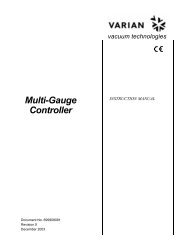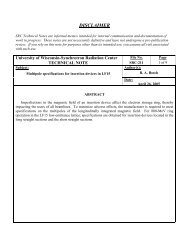SRC Users' Meeting - Synchrotron Radiation Center - University of ...
SRC Users' Meeting - Synchrotron Radiation Center - University of ...
SRC Users' Meeting - Synchrotron Radiation Center - University of ...
Create successful ePaper yourself
Turn your PDF publications into a flip-book with our unique Google optimized e-Paper software.
The sample manipulator has a cool<br />
down time <strong>of</strong> six hours. This long time<br />
constant is a result <strong>of</strong> the large thermal mass<br />
<strong>of</strong> the cold finger. The cryo head itself<br />
reaches a minimum temperature <strong>of</strong> ~10K in<br />
less than an hour under no load conditions.<br />
Temperature measurements with a calibrated<br />
GaAlAs diode mounted on the Ti-sample<br />
slug indicate a minimum sample temperature<br />
<strong>of</strong> ~18.5K. Another test investigated the<br />
impact radiative heating had on the minimum<br />
temperature, the difference between having<br />
the sample area shielded and unshielded was<br />
~ 4K.<br />
Extrapolating the temperature versus<br />
heater power curve for the two permanent<br />
diodes to 10K provides an estimate <strong>of</strong> the<br />
heat load at the inner stage to be ~0.5 W.<br />
This heat loss includes all sources <strong>of</strong> head<br />
load on the inner stage such as radiative heat<br />
and heat leak from the outer to inner stage<br />
(titanium balls and worm gear interface).<br />
By engaging the worm shaft with a<br />
non-magnetic ball driver, the polar angle can<br />
be actuated while the sample is in measuring<br />
position at an azimuthal angle <strong>of</strong> ~0 degree.<br />
The ball driver is attached to a retractable<br />
externally mounted rotary-linear feed<br />
through. The additional thermal losses<br />
imposed by the ball driver are minimal.<br />
While engaged for longer time periods, the<br />
temperature increase at the sample was only<br />
~0.2K.<br />
The functionality <strong>of</strong> the polar angle<br />
scan and the reproducibility <strong>of</strong> the<br />
mechanism were also tested in the<br />
photoemission chamber under UHV<br />
Figure 1 - Fermi Surface <strong>of</strong> BiSb alloy single<br />
crystal measured at a photon energy <strong>of</strong> 18 eV<br />
conditions. The improved thermal positional stability allowed photoemission<br />
measurements to be taken on a small sample (< 1 mm diameter) as it was heated from 18<br />
to 280 K without the need to reposition the sample. The figure on the right shows a twodimensional<br />
photoemission intensity map <strong>of</strong> a Bi0.86Sb0.14 crystal near the Fermi<br />
energy which was measured at 50K utilizing the newly added polar angular axis.<br />
Acknowledgements<br />
The <strong>Synchrotron</strong> <strong>Radiation</strong> <strong>Center</strong> (<strong>SRC</strong>) is funded by the National Science Foundation<br />
(NSF) under Grant No. DMR-0884402.
















